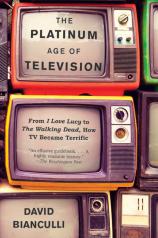The Platinum Age of Television: From I Love Lucy to The Walking Dead, How TV Became Terrific
Review
The Platinum Age of Television: From I Love Lucy to The Walking Dead, How TV Became Terrific
It almost seems unfair when handing out the Emmy Awards that network shows like “The Good Wife” have to compete with no-holds-barred, balls-to-the-wall programs like “Breaking Bad” on basic cable and “Game of Thrones” on premium channels. There are topics the former can’t touch and certainly can’t approach in terms of language, violence and sex.
But it’s all good, writes veteran television critic David Bianculli in this ambitious collection on the history of the medium.
Bianculli breaks THE PLATINUM AGE OF TELEVISION into 15 very specific genres --- from soap operas to westerns to law to variety to several separate sitcom designations (including his own invention, the “splitcom,” a hybrid of domestic and workplace comedies). He selects five shows as “key evolutionary stages” within each category that he believes changed the industry as far as anything that came before. Individual examples include “Hill Street Blues,” “All in the Family” and “M*A*S*H,” the last of which sought to find the humor within the horrors of war.
"...[an] ambitious collection on the history of the medium.... Bianculli fills valuable space with profiles of some of the individuals so important to TV..."
One genre that particularly stands out is “Single Working Women Sitcoms,” which “officially” begins with “The Mary Tyler Moore Show” and ends --- for now --- with HBO’s “Girls.” One can only imagine what Mary Richards would think of how much (and how little) progress has been made along those lines in the last 40-plus years.
All the classic shows are here, plus a few that might raise some eyebrows. And, of course, arguments will ensue when you can’t find your particular favorite (“Rawhide” but no “Bonanza”?). But that discussion is all part of the fun.
Bianculli fills valuable space with profiles of some of the individuals so important to TV: actors, directors, producers, and writers such as Mel Brooks, Louis CK, Tom Smothers, Amy Schumer and Steven Bochco, just to mention a few.
One problem with the book is that in trying to include so much, Bianculli --- a regular on National Public Radio’s “Fresh Air” --- mentions many of these programs merely in passing; too few of them get the full attention they deserve. In order to accomplish such a tribute properly, I imagine the author would have needed to make PLATINUM at least double its 550-plus pages. As much as those legendary entertainers are deserving of the accolades, I would have rather seen that aspect covered in a separate book, giving this one the ability to go into more depth for the highlighted shows.
Another is the tricky issue of how Bianculli handles Bill Cosby. There’s no doubt that he was a pioneer when it comes to the way African-Americans were portrayed on television, from the understated “I Spy”--- the first time a black man was featured prominently as a co-star to Robert Culp --- to “The Cosby Show,” which presented upper-middle class family life in a way that heretofore had not been offered. But the legal troubles Cosby has been facing over the past few years make praising him awkward, and it seems to bring PLATINUM to a screeching halt in its otherwise feel-good aura.
Reviewed by Ron Kaplan on December 16, 2016
The Platinum Age of Television: From I Love Lucy to The Walking Dead, How TV Became Terrific
- Publication Date: September 5, 2017
- Genres: Entertainment, History, Nonfiction, Performing Arts, Television
- Paperback: 592 pages
- Publisher: Anchor
- ISBN-10: 1101911328
- ISBN-13: 9781101911327










